
When you hear the word ceramics, what springs to mind? Is it the vases and figurines from a Grandparent or family friend’s home? Is it a delicate plate or a special mug that comes from a wedding collection or special occasion? Or is it something a little more rustic which builds on the popularity of stoneware and earthenware in the modern ceramics market?
The fact is, the ceramics market covers a wide variety of different decorative and useful pieces – but often, people overlook ceramics as something dainty and old fashioned. This article is designed to introduce the diversity of ceramics, in particular the antique ceramics that grace the windows and display shelves of vintage and antique stores around the UK – and how you can build your own high class collection.
So What Are Ceramics?

Contrary to popular belief, ceramics are not limited to the fine porcelain figures and plates with their intricate details and paint strokes. In fact, porcelain is just one branch of the ceramics market which first came to light over 1000 years ago in China.
Other types of ceramics include earthenware, pottery, and stoneware – and best of all, you probably have the beginnings of a collection at home without even realising it.
The definition of ceramic is a pot or article which is made from heated clay. The finish of this product is what gives the ceramic its more definitive title – with porcelain the most delicate, and earthenware and stoneware giving off much more of a rustic finish.
The very earliest ceramics were the pots and vessels made by humans for practical purposes, using natural materials that they could get their hands on; moulded and then heated over the fire to allow them to set. These products were notorious for remaining watertight and providing resistance against breakage – ultimately explaining why over time, ceramics became some vastly popular.
Modern ceramics are of course very different – as is the case with so many products and materials that we have developed over the years. But for the purpose of this article, and with our focus on antique ceramics rather than the more modern pieces with a variety of ingredients, we are only interested in the original ceramics made with clay:
· Earthenware
· Stoneware
· Porcelain
· Bone China (a form of Porcelain)
Identifying Existing Articles, You May Already Own
If you are looking at starting a collection from scratch, it is worth taking a look at the artefacts you already own and establishing which – if any – could be considered an antique ceramic. Often collectors will focus on one particular brand or creator when starting a new collection, or else they will home in on a specific time period that is of interest to them in terms of the design, colours, and finish.
Different manufacturers are known for labelling and marking their pieces in different ways, and this is one of the first things to look out for when identifying antique ceramics. These marks are applied in one of four ways:
· Incised (applied by hand during the heating)
· Impressed (stamped into the clay during heating)
· Painted
· Printed
Both painted and printed markings can be added as an underglaze or an overglaze – either before the glaze and decoration is added, or after as part of the decoration.
Whatever method is used, finding a marking on your ceramic will give you some indication as to the manufacturer and creator, and thus the time period that your ceramic originates from. Some of the most popular manufacturers include Meissen, Royal Crown Derby, Royal Doulton, and Minton – more on them later.
Once you have found any relevant markings, it’s time to move into the decorative techniques.
Antique Ceramic Decoration and Detail
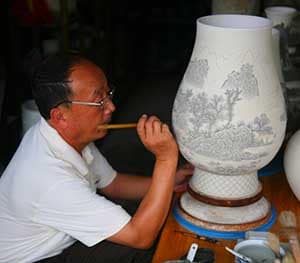
Once you have identified an antique ceramic, understanding the different methods of decoration is an interesting way of assessing the craftmanship and intricacy of the design. For example, the antique blue and white vases which originate from China are notoriously intricate in their detailing, and often dictate patterns derived directly from nature, with dragons and the Cherry Blossom tree of China. These vases tell their own story and are the inspiration behind many copycat products made by modern crafters today – though the originals can always be identified by their porcelain finish and the overall top layer glaze.
Most antique ceramic products will be finished with a glaze of some sort in order to retain the waterproof finish and protect the quality of the material. The decoration on your ceramic is then applied either as an underglaze pattern or an overglaze pattern – literally determining whether the décor came first or second to the glazing process. These decorations would either have been printed or printed, both manual tasks which achieved a unique finish on every piece – and the glaze would have originally been made of lead though after the 19th century these glazes were developed using less dangerous materials – generally crushed flint and glass, salt, or tin, depending on the type of clay and ceramic being created.
Some other types of decoration which are common in antique ceramics include:
· Pate-sur-Pate – a technique where layers of porcelain paste are built up in different colours, creating a ceramic piece which is as textured as it is decorative. This is a particular style that manufacturers Meissen and Minton are known for, with their artefacts boosting the value of collections immensely. Meissen porcelain can always be identified by the blue crossed swords mark, while Minton pieces display an impression of the month of manufacture, a pattern number and the potter’s mark as part of their authenticity checks.
· Sprigging – Sprigging is another example of layering, though instead of colour this is when new details are crafted from clay and stuck to the structure before the final heat process. This type of decoration is mostly found in ceramic figurines with Wedgwood one such manufacturing brand which is renowned for its use of sprigging.
· Trailed Slip – a form of decoration which focuses on colour, dipping the artefact first into a pale coloured slip and then adding and trailing a selection of other colours atop the object to create patterns and decoration which are blended seamlessly into each other. This is a particularly popular decorative method for stoneware pieces, with Slipware one brand and manufacturer which made a name for itself built on Trailed Slip décor.
· Sgraffito – similarly with the trailed slip design, Sgraffito ceramics are created when the object is dipped into the coloured slip and then images and details are carved into the slip before it is allowed to dry and harden. The finished effect is one of colour and texture and achieves some fine details by unsettling the revealing the original colour underneath in the pattern. This is a big decorative technique that you will find in Royal Doulton pieces – identified by the trademark logo. Amazingly, you can often attribute Sgraffito pieces to individual artists through the information provided as well, allowing you to read up on the history of your artist and create a designated collection that centres on their work.
How To Know If Decoration Is Underglaze or Overglaze

When it comes to creating a ceramic collection, being able to tell the difference between an underglazed and an overglazed piece is pretty easy – provided you have the right information.
If a piece has been overglazed, you will quickly be able to find the borders between different paint colours with the tip of a finger. This is because the colour is the last thing added to a piece that has been overglazed, and so there is no protective barrier on top smoothing that surface back out.
An underglazed piece will therefore present a much smoother finish to the touch. Another way to identify an underglaze piece is to hold it up to the light – if the light reflects off and obscures the pattern or detail, you know that pattern is contained underneath a layer of glaze.
Some Standout Antique Ceramic Pieces to Look Out For
Whether you’re into figurines, dinner plates, ornaments or vases, collecting antique ceramics can provide some incredible insight into the artistry of manufacturers and individual creators, and can also be a lot of fun as you explore both online and nationwide at different antique events and auctions.
Here are some of our standout pieces and things to look out for as you dive into the world of antique ceramics.
Cloisonne Vases
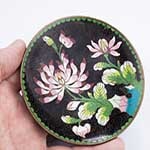
Cloisonne is a decorative technique whereby colours are separated into different patterns by thin strips of gold metal or wire – creating the illusion of texture. These vases tend to originate from oriental countries with a very smooth finish thanks to the layering of enamel which is poured into the different cells created by the wire and then heated in a kiln. The intricacy of these pieces cannot be overstated. View cloisonne products here…
Antique Chinese Blue and White Vases
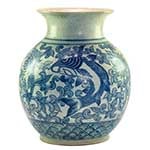
These are typical of the oriental vases that originate in China, and as we have already stated they tend to showcase very natural imagery with Chinese dragons and trees adorning the white background. These were made of porcelain and then Bone China, using the underglaze technique. View antique Chinese blue and white products here…
Royal Doulton
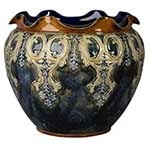
Royal Doulton has held a strong name in the ceramics businesses since 1815, with authentic stoneware and decorative bottles now fetching big money at auctions. The brand was granted the royal warrant in 1901 by King Edward VII with a growing reputation that included bone China alongside its original stoneware pieces. The growing diversity of the Royal Doulton collection has meant that this is a manufacturing brand that plays into a series of different collector preferences – with figurines, jugs and dinnerware all a big part of the brand. In 1960 Royal Doulton introduced English Translucent China as an alternative to Bone China and sales boomed once again. View antique Royal Doulton products here…
Royal Worcester
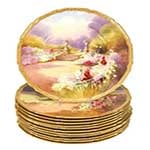
Royal Worcester is a manufacturer with a focus on fruit decoration and porcelain products, creating three-dimensional visuals using the layering of colour and shadowing as part of a detailed decorative finish. From there, Royal Worcester pieces are finished by a gilder who adds a little something special in the form of gold detailing. The brand has been the home of several renowned painters and as such antique ceramics from the Royal Worcester collection are now some of the most popular in the world. Every piece is unique and goes through a rigorous process of quality control before being handed to the customer – finished with the official stamp of authenticity. Today there is an entire museum dedicated to the brand, for those who cannot afford a genuine piece for their own collection. View antique Royal Worcester products here…
Your Next Steps To Buying Antique Ceramics
Collecting antique ceramics is a way of deciphering and celebrating the craftmanship that went into old styles of home decoration, with very few products and production methods today mimicking the process of creating a ceramic vase or a figurine.
To get started on your journey, familiarise yourself with the core techniques of ceramic production and the way that each is finished, and research some of the manufacturers renowned for production in your chosen area. As manufacturers and brands became better known and more recognised in the market, stamps of authenticity were changed and adapted so it is always worth checking out a seller before you purchase and, where possible, gaining proof of authenticity before committing to a purchase.
And of course, to get the ball rolling, start at home. You never know what you might find!
